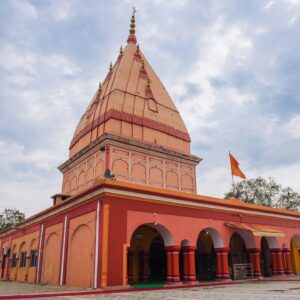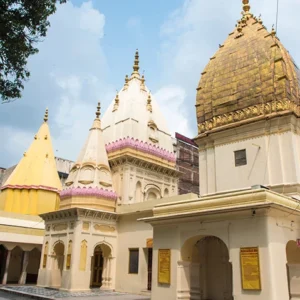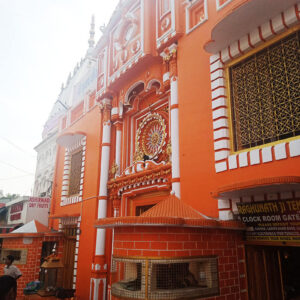Introduction
Nestled in Jammu city, the Raghunath Temple is among the most esteemed pilgrimage sites of northern India. A temple dedicated to Lord Rama, an incarnation of Lord Vishnu and the hero of the Ramayana, it is not merely a place of worship, but fully embodies centuries of devotion, architectural achievement and cultural significance from the region. With its towering spires, typical intricately carved interiors, and its atmosphere permeated by the chants and bells of devotion, Raghunath Temple remains a destination for any pilgrim, history buff or traveler discovering the spiritual part of Jammu & Kashmir.
For devotees, the temple is not just a stop on their journey; it is an opportunity to enter the spiritual heart of Sanatan Dharma. For travelers, it is a chance to witness an incredible synthesis of faith, history and artistry. This is the ultimate travel guide by Travelogear Holidays covering everything you need to know about Raghunath Temple, including the history of its spiritual significance, when to visit, how to reach it, travel tips and nearby attractions.



About Raghunath Temple – A Jewel of Jammu’s Spiritual Landscape
In the heart of Jammu city, the Raghunath Temple is widely regarded as one of the biggest temple complexes in North India and attracts thousands of devotees every day. The temple focus is on Lord Rama, however, it includes shrines to almost every major deity in the Hindu pantheon: Lord Vishnu, Lord Shiva, Goddess Durga, Lord Ganesha and more.
The temple complex is made up of seven shrines, each featuring golden-plated spires, representing the eternal home of the deities. What is truly special about the Raghunath Temple is not just its sheer size; it is its pluralistic belief system: it captures the true essence of Sanatan Dharma, with deities able to exist along each other.
Historical Background of Raghunath Temple
The origin of Raghunath Temple is directly related to the history of Jammu and the Dogra dynasty. Maharaja Gulab Singh, the founder of the princely state of Jammu and Kashmir, began building the temple in 1835 CE, which his son, Maharaja Ranbir Singh, completed in 1860 CE.
The temple was built as an expression of reverence and thankfulness to Lord Rama, the most beloved deity of the Dogra dynasty. The Raghunath Temple is constructed in typical ancient north Indian temple style, with design elements borrowed from the Mughal and Rajput architectural traditions.
The temple has been, over the centuries, an emblem of faith and endurance, surviving political transformations, invasions, and natural disasters. Today, Raghunath temple is still among the largest centers of worship in the region and continues to be a vital piece of Jammu’s cultural landscape.
Architectural Splendor and Design
The design of Raghunath Temple exemplifies the art of temple architecture from the 19th century and is built of sandstone and marble predominately over a vast area, consisting of a full temple complex of seven shrines in a row.
Distinctive Architectural Components Include:
- Seven Gilded Domes: Each shrine has a gold dome representing the seven sacred forms of Lord Vishnu.
- Main Sanctum (Garbhagriha): The central sanctum would house the idol of Lord Rama with Goddess Sita and Lord Lakshmana.
- Intricate Designs (Carvings): Likewise, the walls and pillars have scenes from the Ramayana and Mahabharata, in addition to intricate floral designs.
- Manuscript Treasures: The temple has a vast collection of ancient manuscripts and Hindu scriptures in Sanskrit and Persian.
- Sikhara Style Architecture: The columns and tall, yet narrow spires mimic classical North Indian temple architecture.
The temple on the inside is entirely devotional — the smell of incense, hymns being recited in chant, and bell sounds conjuring up an experience that raises the mind and soul.
Spiritual Significance of Raghunath Temple
The Raghunath Temple is of great spiritual significance to all devotees of God Ram, and to all Hindus across the globe. This temple acts as a powerful site for prayer, meditation, religious rites, and the visitation is thought to elevate the experience of spiritual peace, increase prosperity, and liberate oneself of karma.
Key Spiritual Components:
- Throne of Lord Ram: God Ram as the personification of dharma, virtue, and righteousness is worshipped here with great reverence.
- Presence of Vishnu: There are shrines dedicated to all avatars of Lord Vishnu thus construing this temple to be a mini Vaikuntha on earth.
- Energy Vortex: Many devotees believe this temple is a center of spiritual energy where prayers are answered more easily.
- Symbol of Sanatan Dharma: The temple is constructed in a way that captures some of the uniqueness of Hindu worship and it reinforces the unity of divine consciousness.
For pilgrims, offering prayers of this kind at Raghunath Temple is considered a crucial step before their journey to Vaishno Devi, to purify the mind and soul for the pilgrimage experience.
Best Time to Visit Raghunath Temple
The temple remains accessible to devotees year-round, but experiences may differ greatly from season to season. Visiting at the right times can transform a visit into a breathtaking spiritual adventure.
1. March to May – Spring Time
- The weather is pleasant, and the landscapes come to life with blooming flowers that provide the perfect time of year to visit the temple.
- Spring time is considered the best time of year to take a break for family vacations while sightseeing comfortably.
2. June to September – Monsoon Time
- This season is all about the brief rainy showers that cause the surroundings to turn lush, green, and beautiful.
- Choice times for visiting are generally low crowds, but be sure to check the local weather forecast before traveling.
3. October to February – Winter Time
- You should love visiting in the brisk air of winter, festive vibes during Dussehra, Diwali, and Ram Navami celebrations.
- This is a great time of year to visit a site of pilgrimage if you are looking for a spiritually captivating experience.
- Pro Tip: To enhance your journey even further, visit in the morning or the evening aarti to fully engage in the experience.
How to Reach Raghunath Temple
The temple is located in the center of Jammu city and is easily accessible by air, rail, and road.
By Air:
Jammu Airport (Satwari Airport) is about 8 km from the temple. There are regular flights to Jammu from Delhi, Mumbai, and other cities.
By Train:
The Jammu Tawi Railway Station is about 5 km from the temple, and you can reach Jammu by train from virtually any city in India.
By Road:
There are well-connected national highways to Delhi, Amritsar, Srinagar, and Chandigarh. Local transportation, including taxis, auto-rickshaws, and buses, are available from any part of the city.
Temple Timings and Rituals
Opening Time: 6:00 AM
Closing Time: 8:00 PM
Aarti Timings: Morning (6:00 AM) and Evening (7:00 PM)
Special pujas and rituals take place on the occasions of Ram Navami, Diwali, and Dussehra that attracts thousands of devotees from across the country.
Darshan Tips for Pilgrims
- Dress Code: Modest and traditional attire is required.
- Shoes: You will leave your shoes outside the temple.
- Offerings: Flowers, fruits and sweets are auspicious.
- When to go for Darshan: In the early morning or late evening.
- Photography: No photography is usually allowed inside the sanctum.
Festivals Celebrated at Raghunath Temple
The temple bursts forth with celebration and religious excitement during several major Hindu festivals:
- Ram Navami: The festival of the birth of Lord Rama is celebrated with elaborate aartis, bhajans, and parades.
- Diwali: The temple is filled with lights and decorations.
- Dussehra: A symbolic re-enactment of the triumph of good overcoming evil.
- Janmashtami: The festival dedicated to Lord Krishna, where special prayers and observances occur at the temple.
Nearby Attractions to Explore
Embark on a spiritual exploration of nearby sites:
- Ranbireshwar Temple: One of the largest temples of Lord Shiva in North India.
- Bahu Fort and Temple: Historic fort site with Kali Temple.
- Peer Kho Cave Temple: Ancient cave temple to Lord Shiva.
- Mubarak Mandi Palace: A rediscovery of the royal Dogra Heritage.
- Vaishno Devi Temple: One of the most attended destinations in India about 50 km from Jammu.
Travel Tips for First-Time Visitors
- Schedule your visit for the morning to avoid crowds.
- Be respectful of local customs and traditions within the temple.
- Bring cash for offerings and donations.
- Avoid going in the peak afternoon hours of the summer months for more pleasant temperatures.
- Plan and book your accommodation for festivals in advance.
Conclusion
The Raghunath Temple in Jammu is more than an architectural masterpiece — it is an authentic celebration of devotion, culture, and grace. Each part of the temple complex embodies faith in a way that has stood the test of time. If you visit to say your prayers, admire its remarkable architecture, or simply to soak in the ambience, you are guaranteed to have a memorable experience.
For those who would like to have a deeper sense of connection to faith, culture, and beliefs, a visit to Raghunath Temple should not only be recommended but necessary. With Travelogear Holidays assurance your journey to this historical temple will be as smooth, exciting and without doubt memorable as possible.
Top 10 FAQs about Raghunath Temple Jammu
1. What is the best time to visit Raghunath Temple?
March to May and October to February offer pleasant weather and festive experiences.
2. Who built the Raghunath Temple?
It was initiated by Maharaja Gulab Singh and completed by Maharaja Ranbir Singh in the 19th century.
3. What are the temple’s opening hours?
The temple is open daily from 6:00 AM to 8:00 PM.
4. Is there any entry fee for visiting the temple?
No, entry to the temple is free for all visitors.
5. How far is Raghunath Temple from Jammu Airport?
The temple is approximately 8 km from the airport.
6. Are there any accommodations near the temple?
Yes, Jammu offers a wide range of hotels and guesthouses near the temple.
7. Can non-Hindus visit the temple?
Yes, visitors of all faiths are welcome, but they are expected to respect temple traditions.
8. Are there guided tours available?
Yes, several travel companies, including Travelogear Holidays, offer guided temple tours.
9. Is photography allowed inside the temple?
Photography is generally prohibited inside the sanctum but allowed in the temple courtyard.
10. Can I visit Raghunath Temple and Vaishno Devi on the same trip?
Absolutely. Many pilgrims include both temples in a single pilgrimage itinerary.
How to book Raghunath Temple Tour Packages With Travelogear Holidays?
For a seamless and exceptional booking experience,
Contact Travelogear Holidays at: reservationtravelogearholidays@gmail.com or call us at : 9906903196

